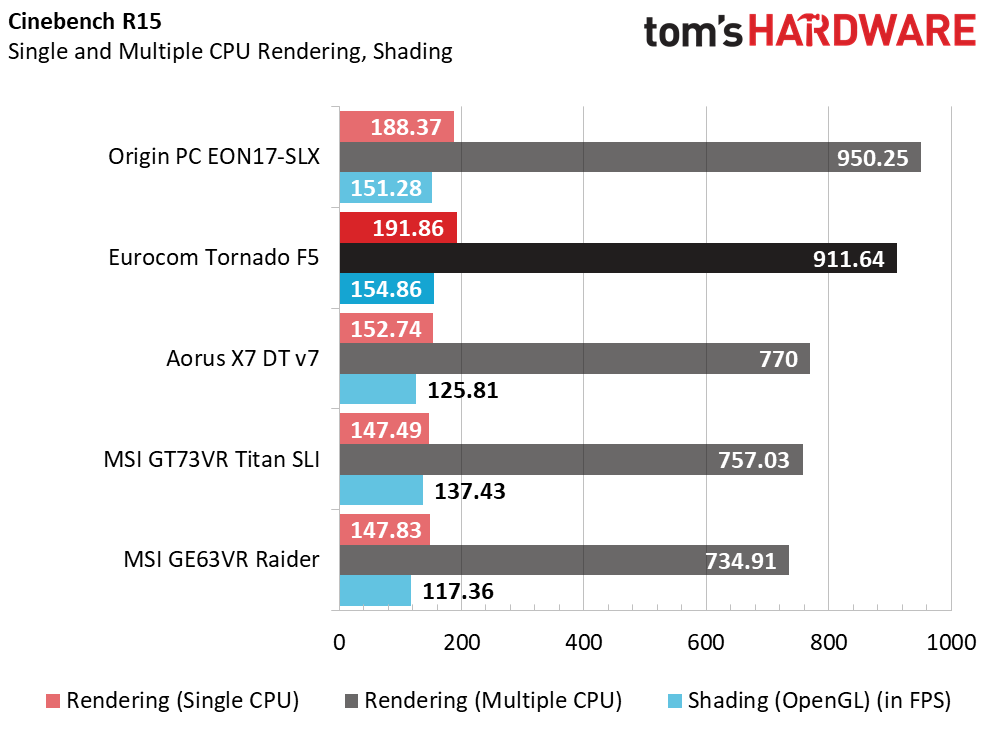Eurocom Tornado F5 Gaming Laptop Review
Why you can trust Tom's Hardware
Synthetic Benchmarks
The Eurocom Tornado F5 features the Nvidia GeForce GTX 1080, the strongest GPU available for a laptop. It also boasts a desktop processor, the Intel Core i7-7700K. That's a powerful combination on paper. These are buffeted by 16GB of DDR4-2400 memory, a 250GB M.2 SSD, and a 1TB 7200RPM HDD for additional storage. You get a 15.6" Full HD (1920x1080) IPS display with a matte coating.
For comparison purposes, the Tornado F5’s main contender is the Aorus X7 DT v7, which also comes equipped with a GTX 1080. The main difference between the two will be the X7’s mobile i7-7820HK, which is overclockable, but doesn’t have the computational power of the i7-7700K. The rest of its components are fairly standard: 16GB of DDR4-2400 memory, a 256GB M.2 SSD, and a 1TB 7200RPM HDD. What makes the Aorus unique is its 17.3” Quad HD (2560x1440) display with a 120Hz refresh rate and G-Sync support.
There’s only so much performance you can squeeze out of a single GPU, so the next logical step is two GPUs. The MSI GT73VR Titan SLI features two GTX 1070s. It also contains an i7-7820HK, 32GB of DDR4-2400 memory, two 256GB M.2 SSDs running RAID 0, and a 1TB 7200RPM HDD for additional storage. It has a 17.3” Ultra HD (3840x2160) matte IPS display with G-Sync. The Titan SLI will highlight the benefits of a second GPU as well as the drawbacks.
What’s better than two GTX 1070s? Two GTX 1080s, of course! The Origin PC EON17-SLX delivers just that, along with a desktop i7-7700K CPU, 16GB of DDR4-2400 memory, a 512GB M.2 SSD, and a 1TB 7200RPM HDD. Similar to the Titan, the EON17-SLX features a 17.3” UHD IPS display with G-Sync technology.
Finally, we’ve thrown the MSI GE63VR Raider into the fray. The Raider is packing an i7-7700HQ CPU, a GTX 1070, 32GB of DDR4-2400 memory, a 512GB M.2 SSD, and an additional 1TB 7200RPM HDD. Like the Eurocom, it has a 15.6” FHD display, but the similarities end there. The Raider’s display has a 120Hz refresh rate and it doesn’t use an IPS panel. Performance-wise, this should be the least powerful system in our comparisons. We're including this just for comparison purposes, as we typically do, so that you can gauge exactly where the upgraded components of our system under review come into play and where they are potentially not worth the extra cost.
3DMark




3DMark lets us approximate a gaming laptop’s graphical performance. The Eurocom Tornado F5 delivers a higher combined score in the standard Fire Strike benchmark. However, higher resolutions benefit from additional GPU horsepower, so the MSI GT73VR Titan SLI surpasses the Tornado F5 in Fire Strike Extreme, Fire Strike Ultra, and Time Spy. Still, the Eurocom’s more powerful CPU helps it maintain a steady victory over the Aorus X7 DT v7.
Cinebench R15
Cinebench features three tests. The single and multi-core tests are, as you might’ve guessed, CPU based. The OpenGL shading test leans on the GPU. (Note: There's no SLI support in Cinebench.) The Tornado F5’s single and multi-core scores far exceed the mobile processor-based competition (20-23% faster single core performance and 16-17% faster multi-core performance compared with laptops sporting 7820HKs). The Eurocom’s greatest competition in Cinebench is the Origin PC EON17-SLX, which provides similar scores thanks to its i7-7700K.
Get Tom's Hardware's best news and in-depth reviews, straight to your inbox.
CompuBench
The CompuBench Bitcoin Mining test is more GPU-dependent, so the Eurocom unit doesn’t outperform the X7 by nearly as much as it does in Cinebench. The Tornado F5 performs about 8% better in Video Processing, but only about 3% better in Bitcoin Mining. CompuBench tests don’t support multi-GPU setups. As a result, the Eurocom laptop performs better than the Origin PC, whose second GTX 1080 essentially goes to waste.
IOMeter


We perform an IOmeter test on each laptop’s primary drive to measure random and sequential speeds. The Tornado F5 features a 250GB Samsung 960 EVO SSD, the X7 features a 512GB Samsung SM951, the EON17-SLX contains a 512GB Samsung 960 Pro, the Titan SLI has two 256GB Samsung SM951s running in RAID 0, and the Raider contains a Samsung PM871. This is yet another battle of the Samsung SSDs.
The Eurocom’s 960 EVO just about matches the Titan SLI’s RAID 0 array in 4K random speeds, with slightly lower read speeds and slightly higher write speeds. The Origin PC’s 960 Pro delivers similar 4K random speeds, while the Aorus’ SM951 falls behind slightly. Rest assured, all of these laptops are ideal for handling application-based tasks. However, the 960 EVO of the Tornado F5 doesn’t quite stack up in 128K sequential speeds, so you might notice a small delay when accessing large files. This still isn’t as bad as the Raider’s meek PM871.
PCMark 8
PCMark 8 features workloads that use the Microsoft Office and Adobe Creative suites to gauge a system’s performance more accurately than Futuremark’s standard home, office, and creative workloads. These tests are best handled by a powerful CPU, so the Eurocom delivers splendid performance in both suites, and only definitely loses to the EON17-SLX. While the scores paint a favorable picture for the Eurocom laptop, you shouldn’t experience a noticeable performance problem with any of the laptops in this comparison set.
MORE: Best Gaming Laptops
MORE: Gaming Laptop Previews
MORE: All Laptop Content
Current page: Synthetic Benchmarks
Prev Page Introduction & Product Tour Next Page Gaming Benchmarks




